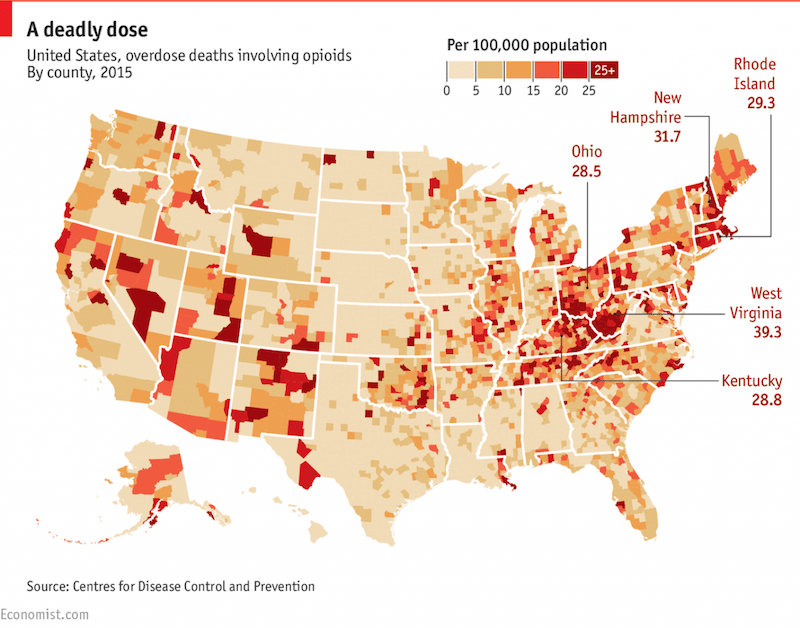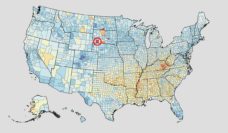As of 2015, opioid misuse accounted for over 33,000 annual US deaths—the equivalent of approximately one death every 15 minutes. Overdoses have risen unremittingly since 1999 and are now outpacing other leading causes of death in US adults aged 25-44 years, even as medical care providers and policymakers have acted to restrict opioid prescriptions.
To effectively respond to this health crisis, it is critical to understand the interaction of factors that has driven its emergence and modulated its persistence. An examination of the time period in which the crisis unfolded, as well as the communities preferentially hit, suggests a process driven not merely by geographic exposure, but by severe economic strain and protracted war.
The trajectory of opioid misuse in the United States
Increasing attention has been paid in recent years to the role of US opioid prescribing practices in fueling substance misuse. Beginning in the mid-2000s—with recognition that increases in prescription opioid supply presaged steadily increasing rates of opioid-associated deaths—federal regulators introduced oxycodone reformulation incentives in an effort to limit misuse. Subsequent declines in oxycodone-associated death rates were accompanied by sharp increases in the rate of heroin-associated deaths. Since then, opioid-associated death rates have continued to rise precipitously in pockets throughout the United States. Prescribing practices, while an important part of the story, are unlikely to fully explain the paroxysmal spikes in both first-time users and non-opioid drug overdose deaths.


Notably, the decade was marked by the 2007-2008 financial crisis, which disproportionately besieged already declining manufacturing and coal-mining industries in the counties now suffering the highest rates of drug-related deaths. West Virginia and Kentucky counties account for the vast majority, with death rates up to nine times the national average. Both states rely heavily on Appalachian coal-mining and manufacturing employment, jobs which have largely disappeared in recent years. Other counties reporting similarly high rates of drug-related deaths—including Virginia’s Dickenson County, Utah’s Carbon County, and Colorado’s Las Animas County—have likewise experienced the crisis in the setting of shuttered coal and manufacturing lifelines. These jurisdictions are an estimated 400-4,700 percent more reliant on oil, gas, and mining employment than the average county within their respective states.

(Click on interactive map for trajectory over time by state)
The era has also been characterized by over 3.9 million U.S. veterans returning from conflict zones. Past reporting on New Mexico’s Rio Arriba County—which ranks third in US drug-related death rates and has battled opioid misuse for several decades—links the initial onset of the crisis to war-time veterans returning from Vietnam. In recent years, the county has also been adversely affected by mine closures and economic downturn.
Both disenfranchised laborers and veterans are populations particularly vulnerable to substance misuse, likely due to higher rates of chronic pain and mental health symptoms, such as anxiety, depression, and post-traumatic stress disorder.
Rethinking addiction
These facts challenge the notion of drug misuse as an uncontrollable or genetically-predetermined response. Misuse does not appear to follow simple Mendelian inheritance patterns, nor do all exposed individuals appear equally vulnerable to addiction. Instead, misuse most often afflicts persons who share psychosocial mental health stressors such as prior trauma, stigmatization, unemployment, or poverty. The interaction of stressors and a lack of reward stimuli may create a noxious, self-reinforcing loop further complicated by chronic misuse-associated changes in brain physiology.
A robust body of longitudinal research has charted the long-term consequences of stress accumulation and intensity during childhood on physical and mental health. These stressors, known as Adverse Childhood Experiences, are strongly linked to an elevated risk of substance misuse throughout life. Similar associations have been observed within the field of neuroscience.
Implications for response efforts
Considering substance misuse to originate as a coping mechanism driven in part by underlying mental health stressors fundamentally transforms our approach to addiction prevention and management. It favors interventions which work to address these stressors in concert with addiction counseling and pharmacologic therapy when indicated. The extent to which economic- and trauma-related stressors may be contributing to evolving rates of opioid misuse is presently unknown. Further study of this association could prove critical to the development of a successful response to the opioid crisis, and should be carefully considered by public health actors and lawmakers.
Feature image: Cindy Shebley, 20171014-IMG_4445.jpg used under CC BY 2.0. “A Deadly Dose” Daily Chart March 6, 2017 from The Economist. Coal mine employee maps: U.S. Energy Information Administration. Graph: FRED Economic Data, All Employees manufacturing.













